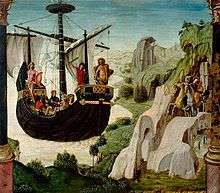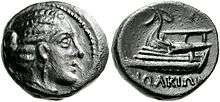Argo


In Greek mythology, Argo (/ˈɑːrɡoʊ/; in Greek: Ἀργώ, meaning 'swift') was the ship on which Jason and the Argonauts sailed from Iolcos to Colchis to retrieve the Golden Fleece. She was named after her builder, Argus.
Legend
Argo was constructed by the shipwright Argus, and its crew were specially protected by the goddess Hera. The best source for the myth is the Argonautica by Apollonius Rhodius. According to a variety of sources of the legend, Argo was said to have been planned or constructed with the help of Athena. According to other legends she contained in her prow a magical piece of timber from the sacred forest of Dodona, which could speak and render prophecies. After the successful journey, Argo was consecrated to Poseidon in the Isthmus of Corinth. She was then translated into the sky and turned into the constellation of Argo Navis.[1]
Several authors of antiquity (Apollonius Rhodius, Pliny,[2] Philostephanus) discussed the hypothetical shape of the ship. Generally she was imagined like a Greek warship, a galley, and authors hypothesized that she was the first ship of this type that had gone out on a high-sea voyage.[1]
Construction of the Argo
In certain sources the Argo was the first ship to sail the Seas and was crafted by Argus and Athena. It was Athena that taught Tiphys to attach the sails to the mast as he is the Steersman and will need an absolute knowledge of the workings of the ship.[3]
References
- 1 2
 This article incorporates text from a publication now in the public domain: Chambers, Ephraim, ed. (1728). "article name needed". Cyclopædia, or an Universal Dictionary of Arts and Sciences (first ed.). James and John Knapton, et al.
This article incorporates text from a publication now in the public domain: Chambers, Ephraim, ed. (1728). "article name needed". Cyclopædia, or an Universal Dictionary of Arts and Sciences (first ed.). James and John Knapton, et al.
- ↑ Hist. Nat. 1.c.56
- ↑ "The Argo". Jason and the Argonauts. Retrieved 2016-04-10.
External links
| Wikimedia Commons has media related to Argo. |
- Voyage of the Argo – slideshow by The First Post